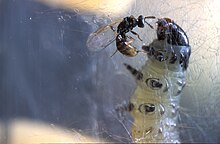Agmostigma is a small genus of hymenopteran insects of the family Eulophidae which contains three species, all described in 1996 by Ubaidillah and LaSalle and so far only recorded from Brunei in northern Borneo.
Anaprostocetus is a genus of hymenopteran insects of the family Eulophidae.
Aulogymnus is a genus of hymenopteran insects of the family Eulophidae.
Baeoentedon is a genus of hymenopteran insects of the family Eulophidae, they are parasitoids of whitefly from the family Aleyrodidae which are found on trees of the genus Ficus. They have been recorded from Australia, China, India, Indonesia and Florida. A fifth species, Baeoentodon farazi, was described from Karnataka, India, in 2017.
Ceranisus is a genus of hymenopteran insects of the family Eulophidae. They are parasitoids of thrips of the order Thysanoptera and may be important in their biological control.

Chrysocharis is a genus of hymenopteran insects of the family Eulophidae. Species in this genus are parasitoids as larvae, with hosts of multiple species being Agromyzidae flies.

Closterocerus is a genus of hymenopteran insects of the family Eulophidae.
Dicladocerus is a genus of hymenopteran insects of the family Eulophidae.
Eprhopalotus is a genus of hymenopteran insects of the family Eulophidae. Their distribution varies between species but ranges from Costa Rica, Mexico to Texas. There are currently 5 species of Eprhopalotus:
Goetheana is a genus of hymenopteran insects of the family Eulophidae. As a parasitoid of thrips, this wasp is used in biological pest control.
Kolopterna is a genus of hymenopteran insects of the family Eulophidae. Kolopterna comprises 14–15 species distributed in the Palearctic and Oriental regions All Kolopterna species are endoparasitoids of gall midges causing galls on various Chenopodiaceae.
Microdonophagus is a genus of hymenopteran insects of the family Eulophidae.
Microlycus is a genus of hymenopteran insects of the family Eulophidae.

Minotetrastichus is a genus of hymenopteran insects of the family Eulophidae. They are parasites of leaf-mining Lepidoptera, Coleoptera, and Hymenoptera.
Omphalentedon is a genus of hymenopteran insects of the family Eulophidae.

Ophelimus is a genus of hymenopteran insects of the family Eulophidae. Members of this genus induce galls on Eucalyptus plants.
Paraolinx is a genus of hymenopteran insects of the family Eulophidae.

Pediobius is a genus of hymenopteran insects of the chalcid wasp family Eulophidae. Like their relatives, the larvae of these diminutive wasps are parasitoids of various arthropods. Some Pediobius are used in biological pest control.

Pnigalio is a genus of hymenopteran insects of the family Eulophidae. Nearly 100 species have been described of which about half may be valid. All species are parasites of other insects. Their biology varies widely among those species that have been studied. Some are ectoparasites, others parasitoid, and still others are hyperparasitoids and their hosts include beetles, flies, hymenopteran and lepidopterans.

Quadrastichus is a genus of hymenopteran insects of the family Eulophidae.







